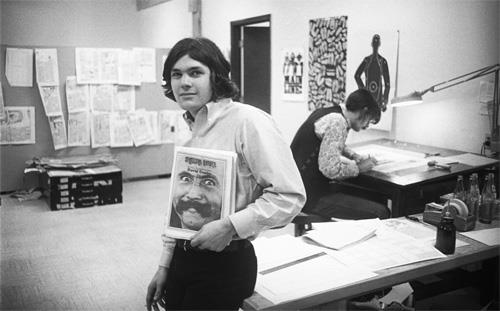
We all know what has happened to traditional print journalism over the last few years, none of it encouraging or beneficial, and that makes a dusted-off documentary on Rolling Stone magazine timely to revisit.
Rolling Stone: Stories From the Edge came out in 2017 and has now been acquired by AXS TV, which will begin showing it Wednesday at 9 p.m. ET.
Directed by Alex Gibney and Blair Foster, with narration by Jeff Daniels, it's essentially an in-house production, more a celebration than a straightforward documentary.
It was released shortly before founder Jann Wenner (top) sold the magazine to the parent company of Variety, so it also serves as a kind of farewell party for the original team, which started the magazine in 1967 and turned it into a music-and-cultural institution.
From its inception through the 1970s, it was a meeting place for serious music fans, the must-read that Wenner and his team envisioned.
Rolling Stone wasn't perfect. It often seemed indifferent to the roots of rock 'n' roll, it was slow on black music, and there were times when it conveyed the impression that important music was what Rolling Stonesaid was important music. It also could get a bit too cozy with artists it was writing about.
That said, it was the defining mainstream music magazine of its era.
First, as Wenner discusses both in vintage and contemporary interviews, it understood the significance and value of popular music in American culture.
Before Rolling Stone, rock 'n' roll and popular music, in general, had been considered a throwaway, an ephemeral and trivial footnote to real culture. Newspapers and magazines covered it as amusing flashpoints ("Elvis shakes his hips!" "Beatlemania!") or annoying aberrations ("the martial music of juvenile delinquents").
The first episode of Stories From the Edge notes how Wenner got together with one of the few mainstream writers who covered the music seriously, Ralph J. Gleason. It gives Gleason the credit he deserves.
Rolling Stone soon began creating its own journalism stars because Wenner realized there were many serious, talented writers who understood popular music and how it was woven into the wider culture. They had been scattered around the country, writing for smaller publications or fanzines. Now Rolling Stone gave them a forum to reach an eager national audience.
Stories From the Edge profiles several of these stars, including Cameron Crowe, Annie Liebowitz, and Hunter S. Thompson. In fact, they take up more of the show than perhaps viewers might want – which is not to say the praise is undeserved.
The series focuses on several touchstone moments for the magazine, including the John Lennon interview in which Lennon talked about being fed up with celebrity, stardom, and the Beatles. In retrospect, this is seen as one of the several phases Lennon went through in his too-short life, but at the time, it was like dumping a bucket of cold water on the rock 'n' roll world. This was not 16 magazine journalism anymore.
As time went on, Rolling Stone would make headlines for Thompson's manic coverage of Richard Nixon and the 1972 presidential election, after which Thompson became more and more of a cult figure. The magazine published political and even military exposes next to long interviews with artists like Bob Dylan and Bruce Springsteen who only sparingly talked to anyone else.
"Long" was an important part of the Rolling Stone mantra. Where much of journalism worships "short," Rolling Stone believed, correctly, that if your subject is interesting enough, readers will commit the time to follow thousands of words.
Rolling Stone today is primarily online. It isn't the force it was because our whole media world today is so much less focused or centralized.
But music journalism lives, and it owes some significant measure of its respectability to Rolling Stone. That's worth a celebration and a memory.